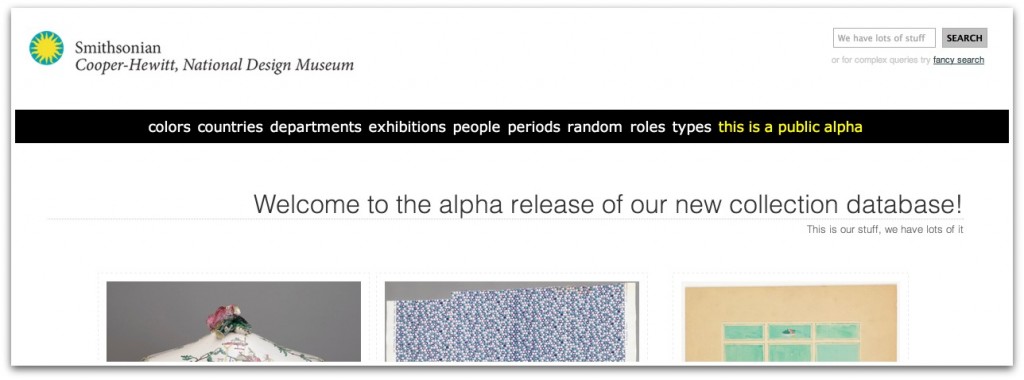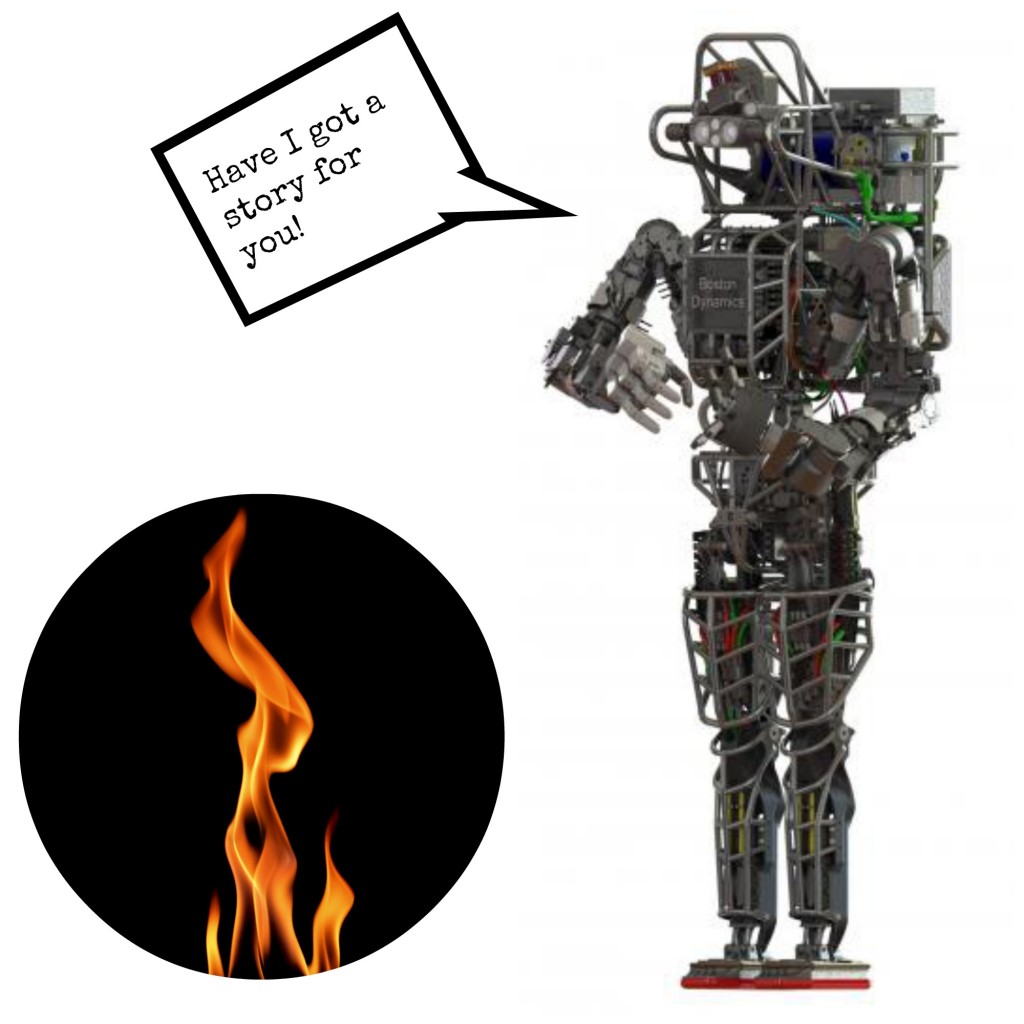Aaron Cope is part of the team reinventing the collections website for the Smithsonian’s Cooper-Hewitt National Design Museum.
Aaron talked with us about digital museum objects and what the future of online collections might look like.
The Copper-Hewitt’s Manhattan building is currently closed for renovation (set to reopen in 2014). While physical access to the collection is restricted during construction, the staff is determined to use digital tools to celebrate the collection and offer delightful ways to interact with it online.
Web visitors looking to browse the Cooper-Hewitt collection find themselves in an “alpha release” of a new collection database. This site is under active development and users are informed that what they see might be buggy, incomplete, or even erroneous.
 What is made visible through this alpha release is a museum grappling with its role in the 21st century—what does it mean for the Cooper-Hewitt and its collections to be part of the network, to be of the Internet? We can see glimpses of what this might mean in interfaces such as browse by color, one of the most popular functions of the collections website. The Cooper-Hewitt team is busy improving the “underlying plumbing and architecture” of the collections data so that more interfaces for searching, browsing, and manipulating the collection can be built on top. The overall goal is to create a “large surface area” on which people can use and interact in the ways that are most useful and interesting to them.
What is made visible through this alpha release is a museum grappling with its role in the 21st century—what does it mean for the Cooper-Hewitt and its collections to be part of the network, to be of the Internet? We can see glimpses of what this might mean in interfaces such as browse by color, one of the most popular functions of the collections website. The Cooper-Hewitt team is busy improving the “underlying plumbing and architecture” of the collections data so that more interfaces for searching, browsing, and manipulating the collection can be built on top. The overall goal is to create a “large surface area” on which people can use and interact in the ways that are most useful and interesting to them.
Developers and “tinkerers” are invited to manipulate data in myriad ways through an exposed API (a structured way that computer programs to talk to one another). The API, Aaron says, “keeps you honest,” because the museum is using the same tools that it makes available to the outside world. Through development of the API and a “services layer,” digital staff hope to meet the needs of exhibition designers as well as build code that scales up gracefully and can be shared and repurposed inside and outside the museum’s walls.
How might visitors interact with the collection digitally in the future? Aaron talked with us about his desire to build services that are “quite, polite, (and) set in the background.” For example, a service built on Twilio could give people a way to easily interact with the collection using SMS (text messaging). A casual browser could send a text message to receive information about a random object. Or a visitor might enter a specific object ID to receive a longer description, which could then be emailed to herself to read later on the subway. Such services would piggyback on the tools people already use outside of a museum. Aaron says this approach is about “having the confidence to be invisible.” What we don’t want to be, he says, is some kind of “History Clippy,” constantly nagging people.
Who is the audience for all of these new and interesting ways of interacting with the collection? While maintaining a core audience of scholars and experts, Cooper-Hewitt staff also want to serve casual visitors who are “busy being awesome in other fields.” And there is a third audience that is becoming increasingly important: the robots, the network itself. How might the network use the collection? Aaron describes a 300 lb. robot, built to leverage the advanced computer power and cheap data storage now available to us. What if robots like that were loaded up with digital data about ALL of the millions of objects in the Smithsonian? And then those robots wandered the earth, stopping at campfires and telling people stories? Is this a future we might soon be living in?


Two aspects of the Cooper-Hewitt’s project strike me as models worth imitating.
1) Making it possible for their collections to be accessed and navigated through tools visitors already use.
2) Being “quiet”
Rather than reinventing the wheel with the limited resources of a museum, it seems smart to capitalize on all the work that’s already been done, much of it in the private and for-profit sector. Visitors don’t need yet another app if the online content can be made readily available through more “basic” functions, functions that are technologically robust and here to stay. It puts me in mind of how scientists approach sending technology to space – they don’t want the latest computer system, they want something that’s been well tested and debugged and has proven robust. That’s not to say that projects that test the limits of technology aren’t worthwhile (and the searching by color palette function does just that), just that if the goal is collections access, thinking about accessible and reliable technology is important.
I am very taken with this idea of being “quiet”. Again, when the goal is collections access for a variety of audiences, it is the collections that should be front and center, not the technology. In my opinion, this is also the best way to build a loyal following – robust content rather than aggressive marketing.
I found myself repeating his clarification between being quiet and being invisible. This is so true of everything and can also be applied to many areas in a museum, more so from the visitor’s point of view. It has to be a seamless intervention on behalf of the museum staff to make the best of the visitor’s experience.
I visited the Cooper Hewitt’s website and I felt like part of the test team. The tone they are using to communicate what they are doing with the website and how they are working with it to improve it and make my experience (as a user) more productive made me feel as part of the team or at least part of a huge focus group. They not only opened up the alpha release of their online collections database, they also allow you into the conversation through the Labs blog. The apparent transparency of the project enhances my experience. I also think it very appropriate that the website be under construction just as the physical building is. There is a parallel between the two sites and I think that also show the public that the digital team did not go on vacation just because there are no exhibitions in the physical building.
And I love the different filters they are using in their searches! They are non traditional ways of searching but the “Color” search is very intuitive for any user, while the “Department” search teaches the user about how the museum’s collections are divided and the organizational structure of the museum.
I also really enjoyed hearing about the subtleties found between being quiet versus being invisible. This was a helpful insight in trying to grasp where and how a museum wants to communicate with its audiences.
The birth of the color search is interesting and I wonder how far it will go and what other kinds of searches might come out of this technology. With ever-improving facial recognition, will there be potential to have software identify common icons like animals or famous figures in art?
This seems like a polarization to the upswing in folksonomies and allowing users to tag images. I can’t help but wonder if this role of the curator will become defunct between general users and computers.
I really liked how he described what he thinks their collections website should be for visitors. He said the website should be “fun, motivated to celebrate to collection and meant to be tangible proof of the direction we are going.” I didn’t think about an online collection in terms of the last idea he mentioned, but I want to use that in terms of my own project and when I work with my own museum. I do agree with him that this is the time for museums to “celebrate” their collection and them having a run of the mill website is not doing their museum’s collection justice since it is so interesting. Also, I really enjoyed hearing him describe in detail how the search by color came into existence for their museum. I was kinda shocked that it only took a weekend to come up with this idea, but I guess when you have a room full of people great things and a lot of ideas can come into being a lot easier than when you are on your own.